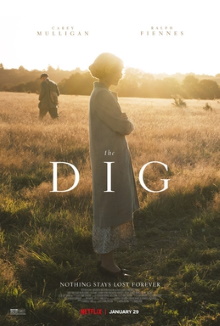Here is another film that is based on a real event: the excavation of what is now known as the Sutton Hoo site in England, one of the most famous and important archaeological sites in the country. It’s a somewhat light film and relies on what is most likely a fictional romantic subplot to give it more of an emotional punch. Still the cinematography is gorgeous and I really love the very idea of a film that is about real archaeology instead of the comic book adventure version that we see most of the time. Solid performances all around and I still can’t get around how different Carey Mulligan looks in this compared to Promising Young Woman.
In 1939, Widow Edith Pretty decides to excavate some ancient burial mounds on the land she owns, at least partly because that is what her husband wanted to do before his death. She hires Basil Brown for the job, who is experienced but self-taught and so is looked down on by academic archaeologists. Brown bonds with Pretty’s young son Robert while she herself is plagued by health problems. As the excavation proceeds and Brown survives a dangerous trench collapse, he suggests that the mound is Anglo-Saxon, far older than previously thought. The academic experts doubt his claims until he finds iron rivets that form part of a ship. Pretty brings in her cousin Rory Lomax to help and the site attracts the attention of Cambridge archaeologist Charles Phillips who takes over the dig after declaring it to be of national interest. He brings in a large team including a young woman Peggy Piggott and they uncover the whole ship. Meanwhile in the background England slides towards war with Germany and everyone waits with bated breath as the world changes.
This is a sweet film that is perhaps a little too obvious in its sentimentality, helped along by the swelling orchestral score. The romance between Piggott and Lomax is extraneous and we can see it coming a long way away from the heavy hints about Piggott’s husband being secretly homosexual. The subplot is entertaining but it does detract attention away from Brown who should be the film’s focus. Still the film manages to avoid being too heavy-handed and the beautiful camera work assuages some of that loss. I do like how all of these little details and side stories, including Brown’s feud with the respectable establishment in London, contribute to the fin-de-siècle feeling of the pre-World War 2 era. Thoughts and feelings of life, love, death and loss are threaded together with both Brown and Pretty being well aware that the mound they are excavating are the cemeteries of people who have died long ago.
By far my favorite of the film’s many disparate themes is how it exemplifies the spirit of discovery and the love of knowledge. The character of Basil Brown certainly represents the democratization of knowledge, showing how even someone without traditional book learning can become an expert through experience and interest. He has even written a book to teach astronomy to laymen and accepts underpaid jobs just because he too wants to know what can be unearthed. Then there is the child Robert who loves science-fiction and imagines the ancient ship that they have uncovered as a starship that voyages through space. The film is saying to us that it’s the same spirit that drives both Brown and Robert, the need to know the past and the need to go out to discover what is as yet unknown.
That this film exists at all is of course wonderful as it is indeed a very worthy project to commemorate the history of the Sutton Hoo dig in this way and hence make it accessible to a wider public. It is already quite remarkable that this film is as historically accurate as it is with most of the major characters being based on real people and a minimum of fictional drama. That said the romance between Piggott and the completely fictional Lomax is pretty shallow and does a disservice to the real Piggott. All in all, this film is somewhat lacking in serious heft, but it does mean well and is put together well enough that it’s an easy recommendation for just about everyone.
